
Original Link: https://www.anandtech.com/show/1946
X1900 XT/XTX Roundup: A Closer Look at the Performance Leader in Graphics
by Josh Venning on February 15, 2006 4:00 PM EST- Posted in
- GPUs
Introduction
The X1900 took a long time in coming, but now that it's here, it's taken its place squarely on the top in graphics card performance. There's little doubt that it's the most powerful card available now, and while it may currently fall into the too-expensive-to-own category for some, it is our duty here at AnandTech to continue to test and report on the capabilities of this excellent card.
Today, we'll be looking at five different X1900's (XTs and XTXs) to see how well they perform against each other. We have both an XT and an XTX by Sapphire, an XTX from GeCube, and HIS, and finally another XT by PowerColor. These are all quality manufacturers, and we expect to see good performance with each of these cards.
To be clear, the purpose of this review is not to compare these X1900s with other graphics cards, but to compare different versions of the X1900 to each other. We've already taken a look at how the X1900 XT and XTX compare to other cards by ATI and NVIDIA, and you can read the article here.
Because each of these cards come factory clocked at reference speeds (XT: 625/725, and XTX: 650/775), the only differences in performance that we will see out of the box are between the X1900 XTs and X1900 XTXs. However, we will also be looking at how well these cards overclock and other aspects such as their prices. User-overclocking is going to be somewhat important here, as the X1900 XT and XTX are fairly close together in performance already, and we're interested to see if our X1900 XTs will be able to clock up to XTX speeds.
It's a little puzzling to us why the X1900 XT and XTX have such large differences in price (the X1900 XTX costs around $100 more than the XT), given that performance is relatively similar between the two. The notion that an XT can be clocked up to or over XTX speeds makes this seem even stranger, So, it certainly seems clear that ATI is hoping to hook those who just can't settle for anything less than the fastest with the XTX. Our thoughts on this aside, ATI has made the most powerful graphics card to date with the X1900, and we plan on taking a close look at a few of them for you right now.
Sapphire X1900 XT & X1900 XTX
Sapphire is a company from which we've seen good results come in the past, and today, we have two different X1900's from them. Most of the X1900's that we have look nearly identical except those made by Sapphire, whose only difference is the small Sapphire logo on the heat sink. Other than this, both the X1900 XT and XTX look exactly like ATI's reference X1900s.
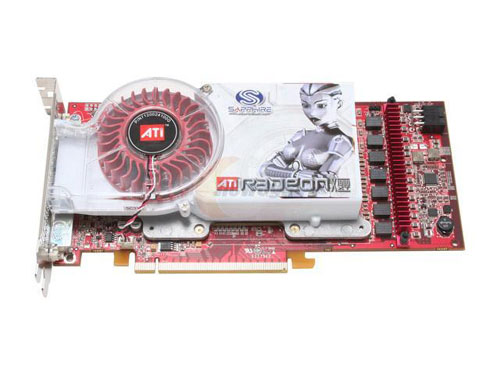
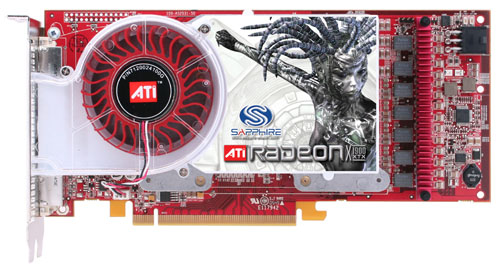
HIS X1900 XTX
HIS is another company that we've dealt with in the past, and their version of the X1900 XTX is the only one of our X1900s to sport a custom HSF of the five in this review. HIS is well known for their liberal overclocking of ATI GPUs, and we have seen nothing but quality products from them.
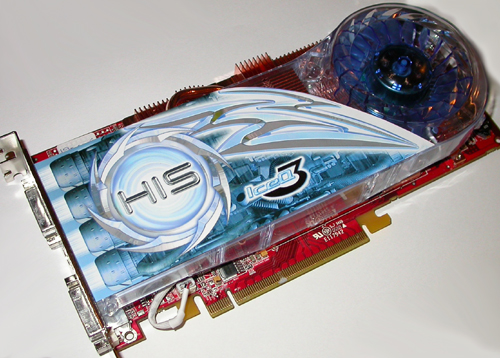
GeCube X1900 XTX
The next card that we have is an X1900 XTX by GeCube, and the look of this card is identical to the reference X1900 XTX, without anything to distinguish them apart, aside from the product number over the fan.
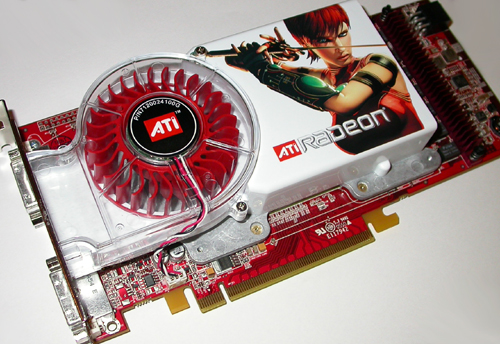
PowerColor X1900 XT
The last part that we have for review is another X1900 XT from PowerColor. As with the GeCube X1900, the appearance of this card is identical to ATI's reference X1900 XT, which also looks exactly like the reference X1900 XTX. The fact that these cards look identical made telling them apart a bit of a headache, and we wish PowerColor and GeCube could have at least slapped their logo on the HSF before shipping them out.
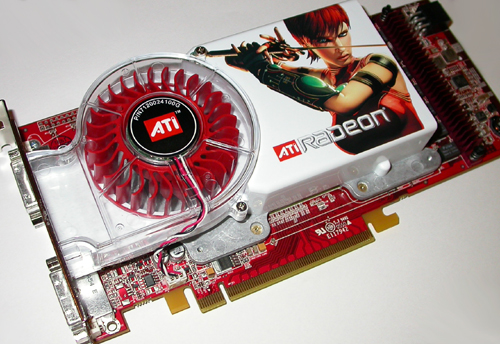
Overclocking/Power Load/Noise
Overclocking these cards was somewhat difficult, as the usual tool that we use (Powerstrip) didn't support the X1900 yet. Instead, we used a program called ATITool to get our overclocks. Unfortunately, we found that ATITool's listed speeds didn't quite indicate actual performance speeds perfectly, so the clock speeds that we were able to achieve yield slightly lower performance on the card. We were, however, able to get a good idea of the overclocking abilities of these cards with this tool. Here are the clock speeds that we achieved:
| Overclock speeds | ||
| Graphics Card | Core (in MHz) | Memory (in MHz) |
| PowerColor X1900 XT | 650.7 | 742.5 |
| Sapphire X1900 XT | 664.2 | 774.0 |
| Sapphire X1900 XTX | 688.5 | 841.5 |
| GeCube X1900 XTX | 679.5 | 801.0 |
| HIS X1900 XTX | 697.5 | 819.0 |
Splinter Cell Chaos Theory Performance
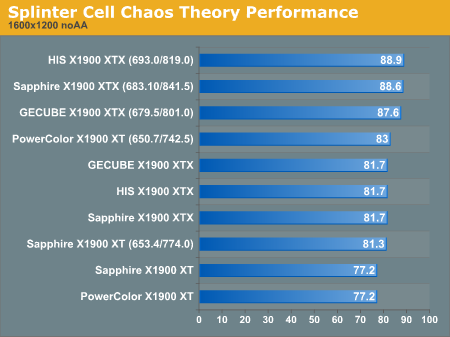
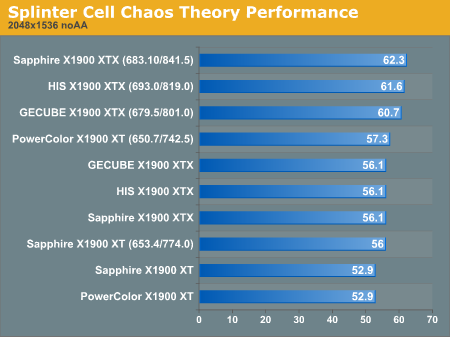
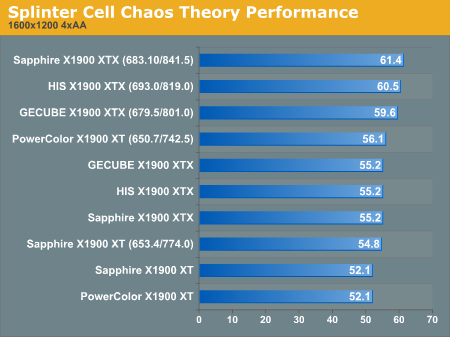
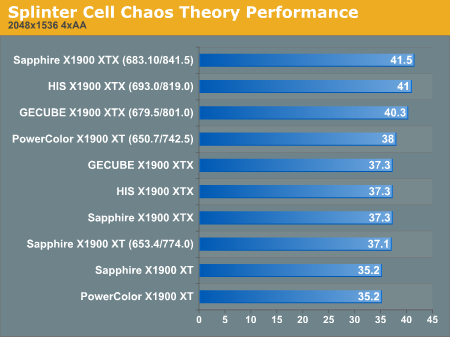
The first thing we can point out here is that the Sapphire X1900 XT did in fact achieve clock speeds slightly higher than a stock X1900 XTX. This is an important discovery, as it may give pause to those who would be quick to choose an X1900 XTX over the less expensive XT. The fairly large difference in price between the two cards is enough to justify buying the X1900 XT and attempting to clock it up to XTX speeds. It's true that the PowerColor X1900 XT didn't quite get up to XTX speeds (650/775), which indicates that not everyone will have this kind of success overclocking their X1900 XT. However, as the graphs show, the performance of the PowerColor X1900 XT and the reference X1900 XTX are close enough to each other. So, the fact that the PowerColor has a slightly lower clock is unimportant.
Overall, the overclocks varied quite a bit with the different cards. The XTXs in particular all achieved memory clocks very different from one another, with the GeCube X1900 XTX doing the worst. The Sapphire cards seemed to overclock the best, something that isn't very surprising given our experiences with their cards in the past. The GeCube and PowerColor X1900s achieved the lowest overclocks, with our GeCube being particularly finicky (crashing, artifacts, etc.). Bear in mind, however, that many cards of the exact type can overclock very differently from one another, so this might not be the case for all GeCube X1900 XTXs.
Power Load
To test the power load of the card, we measure the total watt usage of our test computer at the wall outlet, recording the power usage of our system in two different states. The first state is with the card installed and the computer at idle, and the second is during intensive performance tests (looped Splinter Cell benchmarks). This doesn't give us an exact power measurement of the card, but it helps us get an idea of the kind of power the card pulls.
| Graphics Card | Idle | Load |
| PowerColor X1900 XT | 146 | 315 |
| Sapphire X1900 XT | 148 | 316 |
| Sapphire X1900 XTX | 151 | 336 |
| GeCube X1900 XTX | 154 | 337 |
| HIS X1900 XTX | 152 | 330 |
Interestingly, the X1900 XTs and XTXs drew very similar loads. Of the XTXs, the HIS X1900 XTX drew the smallest amount of power under load, which isn't that surprising given its unique HSF. The Sapphire and GeCube XTXs drew nearly the same amount of power under load. We can see that the X1900 XT does pull a slightly lower load than the XTX, but these are both incredibly power-hungry cards.
Noise
| Graphics Card | dbl level |
| PowerColor X1900 XT | 52.0 |
| Sapphire X1900 XT | 49.6 |
| Sapphire X1900 XTX | 50.2 |
| GeCube X1900 XTX | 51.4 |
| HIS X1900 XTX | 49.5 |
Again, we see that the HIS X1900 XTX stands out somewhat as being slightly more quiet than the other cards, likely due to the different HSF. All of these cards are a bit noisier than most, but this isn't very surprising given their enormous power. For reference, the noise level of the room with the system off was 40.6 dbl.
Test Setup/Performance Tests
We also ran a number of performance tests to let us see the difference between a reference factory clocked and factory overclocked X1900. This will also give us a look at how the X1900 XTX and XT numbers compare, taking into consideration the different user overclocks. We tested three games at 1600x1200 resolution with and without AA enabled. The games that we used (Battlefield 2, Quake 4, and Halflife 2: Lost Coast) had been chosen because they represent a wide range of game engines. We also tested these games with sound disabled. This is the test system that we used:
NVIDIA nForce 4 motherboard
AMD Athlon 64 FX-55 2.6 GHz Processor
1 GB OCZ 2:2:2:6 DDR400 RAM
Seagate 7200.7 120 GB Hard Drive
OCZ 600 W PowerStream Power Supply
Battlefield 2 Performance
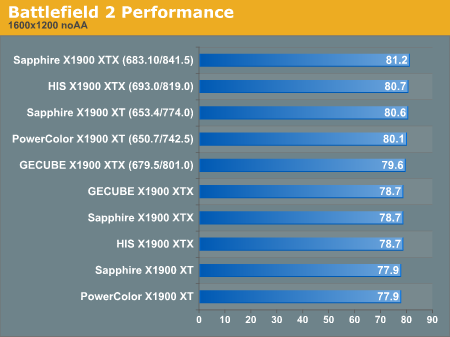
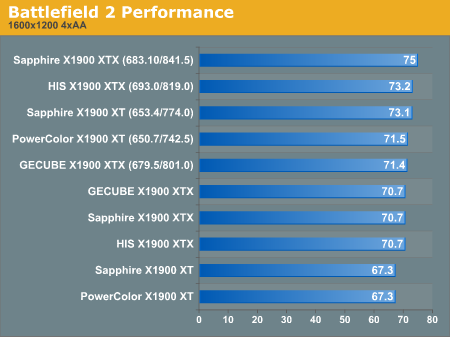
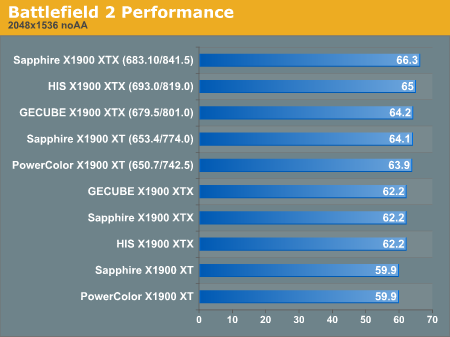
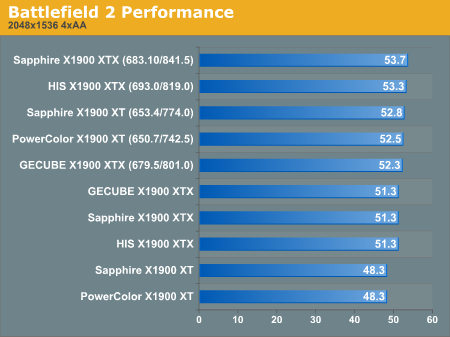
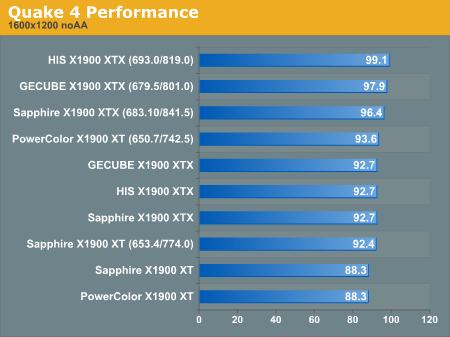
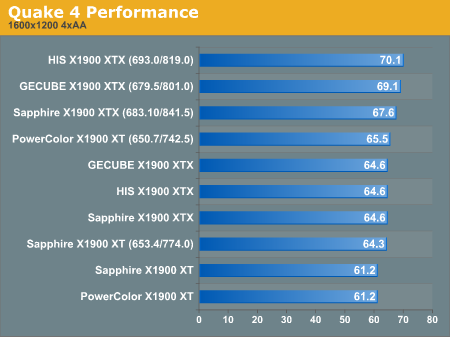
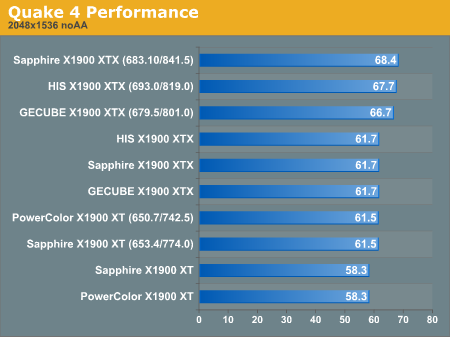
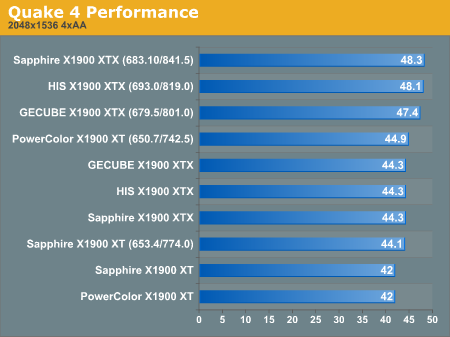
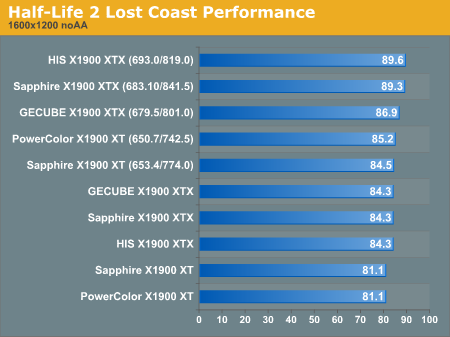
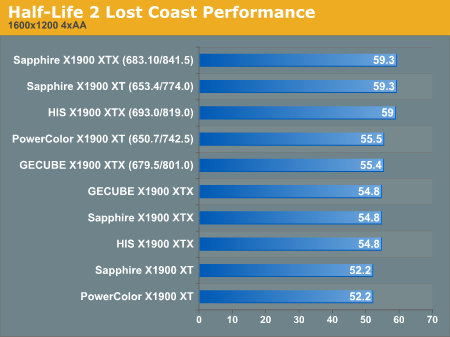
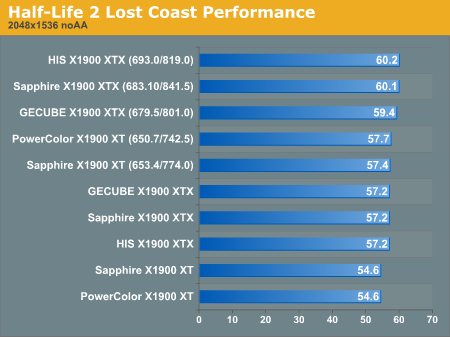
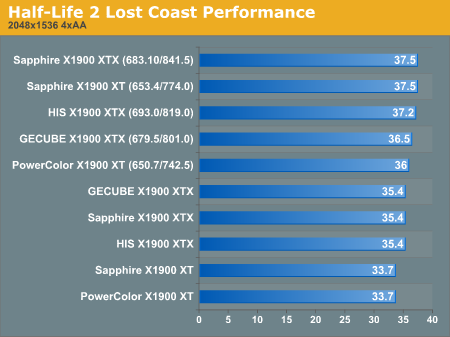
Final Words
The X1900 is one of those cards that is on just about everyone's wish-list. Those who are lucky enough to own one are probably the envy of their friends and also perhaps became broke from the purchase. We know that these are the most powerful cards available right now, and therefore, won't be affordable to many people, but those who can afford one certainly won't be disappointed with their performance. Of course, it's worth pointing out that a card this powerful would only be a necessity (using the term loosely) to those gamers with monitors that can display very high resolutions, and computers that won't cause limitation to the GPU. This makes the card even less practical for the majority of gamers as most of us are still stuck at 1600x1200 or below on our monitors. Nonetheless, the idea of the biggest and the best is too enticing for some to resist, a fact that ATI is probably counting on.
We expressed puzzlement earlier over the big difference in price between the X1900 XT and X1900 XTX, and as we've seen by the numbers, X1900 XT speeds can be boosted up to higher than XTX performance levels. When you consider that the X1900 XTX costs around $80 to $100 more than what the XT costs right now, it makes it a lot harder to justify going with the XTX. Then again, if sheer gaming power is your only concern, the X1900 XTX will give you what you want and then some.
Let’s talk about the prices of these cards now. As we mentioned before, GeCube's X1900 XTX is currently only available outside of the US, and we found one on PC Maniacs for $919 Australian, which translates roughly to $680 USD. This makes this card our most expensive X1900 out of the five by far, and will not make obtaining this card very feasible for those in the US. The HIS and Sapphire XTXs are somewhat similar in price (Sapphire: $582, and HIS: $596), but you'll have to mail in a rebate to get the HIS for this price ($650 before rebate). The two X1900 XTs by Sapphire and Powercolor are both about $500, so either of these might be your best choice when looking for an X1900. We would recommend the Sapphire X1900 XT over the PowerColor because of the game bundle, as well as the slightly better overclocking results that we saw with this card. But if adding more games to your collection isn't a factor, and overclocking seems too dangerous, the cheaper card gets our vote here.
For those who absolutely must have an X1900 XTX, their choice should be fairly clear. At $580, the Sapphire X1900 XTX is the cheapest, and also gets more-or-less the highest overclock of the three. All of these X1900s have very high power draws and noise levels, so if these areas are a concern for you, then the X1900 is not your card. All in all, the X1900 was worth the wait, and with ATI starting to phase out X1800, we're curious to see what might come along from them in the near future. Regardless of this, the X1900 is the embodiment of “next-generation” graphics, and will continue to set the standard for graphics solutions (for at least the next month or so anyway).







